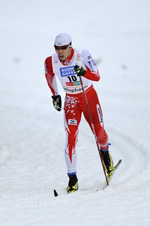Description of Cross-country Skiing
Speed Competition in a Race Across Snow
Cross-country skiing is a winter sport in which participants ski across snowfields. In contrast to alpine skiing, in which athletes glide down an incline, cross-country skiers travel across flat areas and up steep hills. Ski lifts are not used.
Cross-country skiing has received less television exposure in Japan than alpine, snowboard, and jump competitions, and is not very familiar to the Japanese. However, cross-country skiing is an Olympic event, and is popular in Europe and Canada. In Nordic Europe (Norway, Sweden, and Finland) in particular, a wide range of individuals, from children to the elderly, enjoy it on a daily basis.
Some elementary schools in northern Japan include cross-country skiing as part of their physical education classes during the winter. Yuichi Onda's interest in the sport was sparked by just such a class when he was in third grade.
There is also a sport called “Nordic combined,” a competition that combines ski jumping and cross-country skiing.
Equipment
Because of the many flat areas and hills throughout the course, cross-country skiing requires unique equipment.
The width of the skis is about half that of those used in alpine skiing, and they have no metal edges, so they are extremely light and flexible. Another significant difference from alpine skiing is that the skis are attached only to the toe of the boots, with the heel free. The ability of the heel to rise from the ski makes it possible to move very fast both across flat areas and up hills.
Long poles are used, extending nearly to shoulder height. This provides a significant amount of propulsion when pushed against the surface of the snow. Cross-country skiers use not only their legs, but their arms as well to attain speed.
Method of Skiing
Two methods of skiing are used in cross-country skiing: classical and skating.
With classical, skiers glide through two grooves in the snow. Because the skis are kicked back alternately, two types of wax are applied to them, one to allow them to slide more smoothly, and another to stop sliding and allow the kick.
With skating, the skier pushes outward, opening each leg alternately to move forward like an ice skater. It is a method that was developed later in the history of skiing, and provides more speed than the classical method.
Events
Cross-country skiing competitions are not only divided into the classical and freestyle (skating) methods, but consist of a variety of events with different distances and start methods as well.
Distances range from sprint events of about 1.4 km to long-distance events that continue for 50 km or more, with different events being hosted at each meet. Naturally, not only the distances but the course layout and inclines and descents differ from meet to meet, so the athletes must be able to adapt in a flexible manner to every type of course.
There are two basic start methods. The first is a mass start, in which all participants start at the same time. The highlight of this type of start is the maneuvering for position between athletes. The second type is an interval start, in which individual athletes start at 30-second intervals. Because there is little contact between competitors, this start method makes it possible to achieve a fair comparison of times. The highlight of this type of start is the suspense of not knowing the results until the final competitor crosses the goal line.
In addition to these individual events, relay events are also held. These events include four-person relays, as well as a team sprint event in which members of a two-person team take turns skiing, with each racing three times. International meets are competitions between national teams, so the cheering becomes very energetic.
Yuichi Onda’s specialty is the individual sprint. In this event, the top finishers in the preliminary time trials advance to the quarterfinals, the semifinals, and ultimately the finals. Because the athletes participate in multiple races each day, it requires both physical and mental strength.

Back to Top




